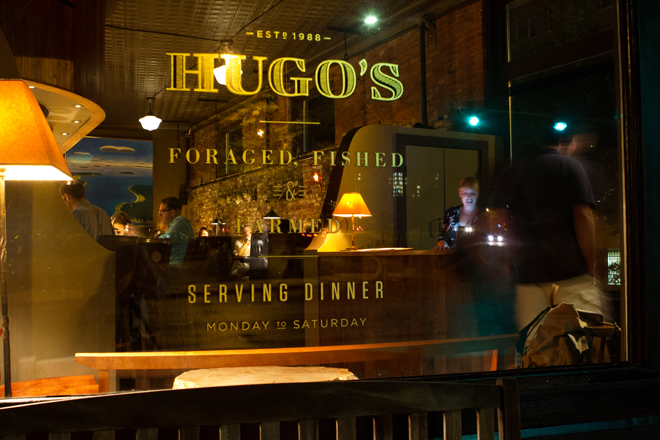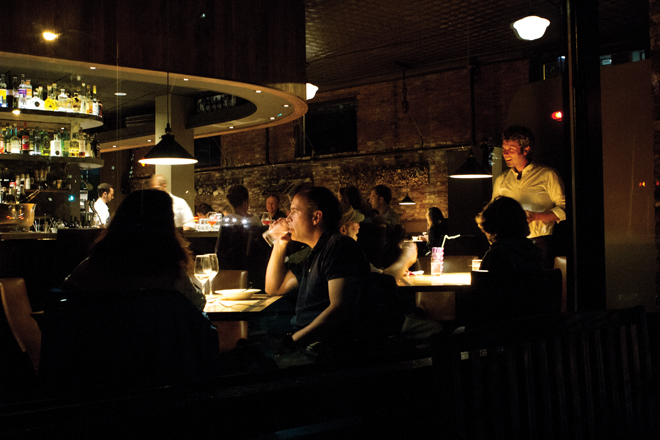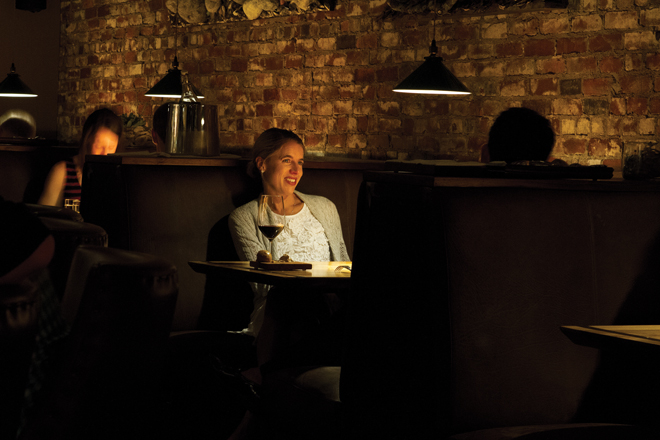Hugo’s
Cauliflower puree. Ichthyic spinal fluid. Kimchi puree. Even for those of us who are apt to drop the phrase “sous vide” into casual conversation, these elements sound mildly daunting. But that has always been a part of the program at Hugo’s. The Portland institution has been pushing diners into new culinary waters for 25 years. Only now, following a renovation and a menu revamp, they’re doing it a little more gently. No more blind tasting menus here—just shockingly good food, composed right in front of your eyes.
Instead of keeping chefs behind a swinging door and out of sight, Hugo’s tears down the barriers between customer and chef, creating a dining experience that is interactive, communal, and even, at some points, thrillingly theatrical. Formerly owned and operated by Rob and Nancy Evans of Duckfat, Hugo’s was purchased in March 2012 by three ambitious restaurateurs and former employees, Arlin Smith, Andrew Taylor, and Mike Wiley. Having cut their teeth on the award-winning oyster bar Eventide, the trio decided to expand next door and take on the challenge of Hugo’s. After spending the better part of last year “running Hugo’s like Hugo’s had always been,” as chef Mike Wiley puts it, they decided to do one massive renovation. They gutted the restaurant, rebuilt the kitchen, and overhauled the menu before Hugo’s reopened in July 2013 for dinner service.
Stepping into the new and improved Hugo’s, the first thing you notice is the huge, curving bar, which divides and dominates the dining space. Behind the bar, chefs are hard at work preparing the night’s offerings. This format may seem familiar, especially if you have had the pleasure of dining next door at Eventide Oyster Co. “We’re trying to get rid of the typical formalities that fine dining seems to inspire,” explains Smith. “In both of our restaurants, the emphasis is on the bar. There are no white tablecloths. You’re at a bar, you’re seeing action, and you’re eating things with your hands.”
In place of linen tablecloths and flickering candles, Hugo’s has shining wood tabletops made from a 160-year-old red birch that was found at the bottom of Moosehead Lake. Steel lighting fixtures hang from the ceiling, lending the space an industrial elegance. As I slide up to the bar for my first meal at the new Hugo’s, I’m struck by how comfortable and spacious it feels. Buttery-soft leather completes the men’s-club vibe, and I settle in easily, ready to start tackling the five-course menu, one exquisite bite at a time.
But first, we have to order. There are three menus offered at Hugo’s: one that focuses on vegetables, another on seafood and fish, and a third centered around meats. “We endeavor to make each menu an expression of the season,” says Wiley. “In the past, we got pushback from folks who didn’t trust the kitchen, so now we made it so diners have more control.” However, it’s clear that Wiley and Taylor enjoy acting as guides, and I opt to relinquish control and let the chefs serve me what they will. And for any readers who choose to dine at Hugo’s after this review, I strongly suggest you do the same—these chefs know their food, and even the so-called “crazy stuff” is really quite delicious.
Our first taste of Hugo’s comes, as is traditional, in the form of starch. My boyfriend and I devour flaky, warm fried garlic biscuits. After hearing Wiley talk at length about their “intellectual kitchen” and the fun they have experimenting with odd ingredients and new ways of cooking (“sometimes we like manipulating the hell out of stuff so that it’s nearly unrecognizable when it lands in front of you,” he confessed just hours before) I am slightly disappointed that my biscuits don’t have a soft bone marrow center, or a frothy coating of cheddar foam, or something of that ilk. Fortunately, this feeling is short lived. A few minutes later, my attentive server sets down a bowl of vivid orange and bright magenta. I don’t have to look at the menu to know that this right here is the fabled chawan mushi, one of the most successful and offbeat items offered at Hugo’s.
According to Wiley, chawan mushi is one of the most popular dishes on the new menu. Made with a five-to-one ratio of liquid to eggs, it’s “like a crème brulée without the dairy,” says Wiley. Although it is traditionally made with dachi, a Japanese fish stock, the chefs at Hugo’s have been experimenting with asparagus, beet, and other vegetable juices. The current iteration gets its beautiful hue from fresh carrots, which also lend the custard a delightful sweetness that is further enhanced by earthy white beets. Black quinoa and light, crunchy purple beet chips complete the dish, turning the diaphanous, summery cream into a playful bouquet of textures. From the first bite, I’m sold on this strange and beautiful creation.
“We try to take flavors people are accustomed to and push them in entirely new directions,” says Wiley when asked about his culinary goals. From the first course to the last, I’m reminded of this statement again and again. As we move from chawan mushi to steak tartare, rabbit with kimchi puree, and other unique compositions, I find myself continually surprised by how familiar—yet utterly new—each bite tastes. Between courses, we watch, rapt, as the chef behind the bar puts the finishing touches on the udon noodle salad, spraying it carefully with a cloud of citrus foam. Before I lose myself in the culinary spectacle, I’m pleasantly brought back to earth as a dainty cup makes an appearance next to my wine glass. It’s one of Hugo’s highly creative mini-courses. This amuse-bouche is served in a teacup and features a base of cauliflower foam, dusted with nori powder and shaved hazelnuts.
“While the diner is in the driver’s seat, we still have the opportunity to hit people with surprise, in-between bite courses, which is really gratifying for us,” says Wiley. “We still get that ‘Oh! Another free surprise!’ reaction, and we get to spread our wings and do some crazy stuff.” Cauliflower foam isn’t a staple in my diet, yet once I taste it I have trouble conceiving of this as a mad creation. The clean vegetable flavor shines, and the light dusting of nori adds a slightly tangy, briny depth. It pairs perfectly with sips of Damilano Arneis. In the interest of getting the full Hugo’s experience, I asked for the wine-pairing menu. Over the next few hours, I move from bright mineral whites to a dark, sweet Mas Amiel, which is rich and smooth, and perfectly echoes the flavors in our dessert course.
We end the meal with two separate desserts: a deconstructed blueberry pie, and a s’mores plate. My boyfriend and I have trouble sharing this final dish, with its pillowy marshmallow meringues, smoked chocolate ice cream, and sweet crispy crust—we both want it all. Not only is this a fantastic way to end a meal, it also perfectly exemplifies the owners’ culinary philosophy: “We want our food to look surprising and new, but still trigger memories of ‘oh, when I got home from soccer practice and my dad would make me that BLT…’” said Wiley. While the precision of the fare is a novelty, and the beautiful plating a visual treat, these s’mores still taste like childhood camping trips and licking my fingers in the smoky, dark woods. Forward-thinking yet rich with history—this is the new Hugo’s.
















